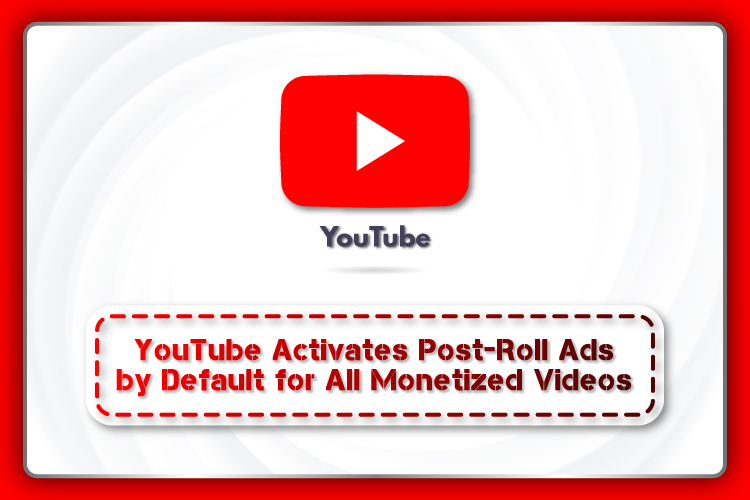YouTube Activates Post-Roll Ads by Default for All Monetized Videos

The popular video-sharing platform, YouTube, has activated post-roll ads by default for all the videos eligible to run ads.
In what has become a regular series on the Creator Insider channel, YouTube has informed the creators about this update through the first published video of the year.
A YouTube member has revealed that any video above 10-minute duration will have post-roll ads activated by default for all monetizing creators automatically.
For your information, a “monetizing” creator is a creator or channel owner who has applied for the YPP (YouTube Partner Program) and has been accepted into it.
Creators belonging to this program are eligible to serve ads in their videos and, in turn, earn a portion of the total revenue depending on the number of views the ads gain.
The platform provides creators with three primary advertising options – pre-roll, mid-roll, and post-roll ads. When publishing a video with at least a 10-minute duration, the creators can choose to run any combination of these types of ads.
While advertising on your videos is optional, it is crucial to know that all types of ads (pre-, mid-, and post-roll) will now be turned on by default. This implies that if you are not cautious enough, chances are you might wind up posting a video that contains way more advertising than you planned.
Nevertheless, creators must take note that even though post-roll ads will now be turned on by default, they can turn it off whenever they want.
They can turn post-roll ads off while uploading the video by unticking the suitable box. However, for existing videos, creators can go to the monetization tab to turn off post-roll ads.
Should I Leave Post-Roll Ads Turned On?
Bearing in mind that the post-roll ads are presented to the viewers after they have finished watching the video, they are actually the least invasive type of ads that the platform offers.
However, you might be taking the chances of wearing out your viewers if you have post-roll ads activated along with pre-roll and mid-roll ads.
So, let’s suppose you are uploading a 10-minute long video with all these three ad types turned on – now that makes up too much advertising for a very short period.
Thus, whether you should leave your post-roll ads turned on or not is something that is best evaluated on a video-by-video basis. You can go through your videos one by one and take their length, content, and popularity into account to determine if it is safe to run a combination of ads on them.
Alternatively, you can also just let things be the way they are and allow your audience to decide for you whether your videos have excessive advertising or not. Given the platform’s history, viewers tend to express their opinions outspokenly in the comments section. So odds are they won’t shy away from telling you to decrease the amount of advertising as well.
Moreover, if most creators leave their post-roll ads turned on, it could wind up being a positive thing for the advertisers. In case post-roll ads become omnipresent on the platform, advertisers could further reap benefits by making unique ads for this particular format.
Below is a brief summary of the specifications for post-roll ads and recommended best practices for advertisers.
Specifications and Best Practices of Post-Roll Ads
In the domain of online advertising, post-roll ads are actually an offbeat and uncommon element. Since they are limited to YouTube and Snapchat only as of now, they are naturally less widespread compared to other ad types – pre-roll and mid-roll ads.
Post-roll ads have specifications similar to any other ad type; however, they can last anywhere between 12 seconds to 3 minutes. But given the nature of these ads, they are the most skippable ads of all. Therefore it is recommended to use shorter duration post-roll ads.
It is highly unlikely for audiences to sit tight for a long time, especially after they have finished watching the video they came to see in the first place. This is the reason it is unwise for advertisers to reuse pre-roll and mid-roll ads as post-roll ads.
Users have short attention spans nowadays. Therefore advertisers must find a way to get their message across in as short a span of time as possible. In addition to this, it would be beneficial to make the most out of one of the significant advantages of post-roll ads,i.e., the ability to click through to a website link.
Last but not least, keep your ads short, generate a sense of urgency, and encourage users to click with a compelling CTA. Try to make your ads as engaging as possible to make the viewers want to stick around and learn more. The key lies in creating ads that are unique, informative, engaging, and are easy to digest, i.e., do not consume too much time. Keep these useful tips in mind, and you will be all set to go.
Wrapping It Up
With YouTube’s recent update, post-roll ads will automatically be turned on for all monetized videos that are more than 10 minutes in length. However, advertisers who do not wish to leave these ads on can also turn it off by either unchecking the respective box while uploading the video or going to the “monetized” tab for existing videos. It varies from content to content whether or not you should leave post-roll ads turned on. Give some thought to it before deciding, or let your audience do it for you in the comments. Finally, this can be an incredible opportunity for the advertisers if most creators choose to leave this feature on. Keep the tips mentioned above in mind to take advantage of this new ad type.
